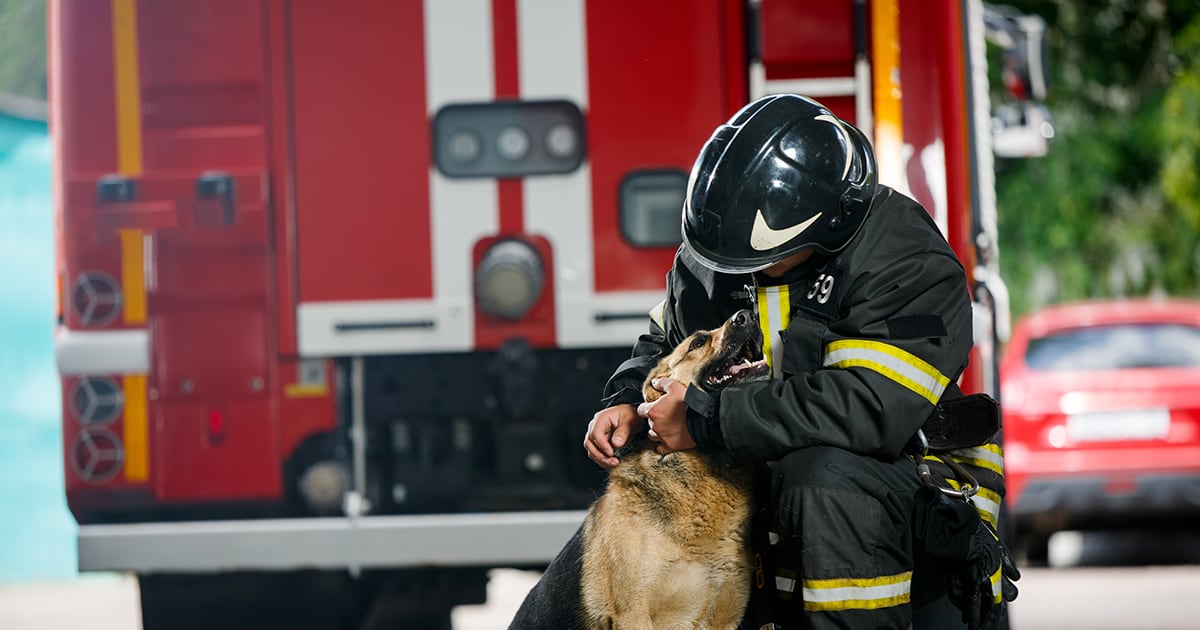National Pet Fire Safety Day, which is observed on July 15 each year, stresses the importance of preparing and protecting pets for unexpected fire emergencies. Taking preventive measures can save your home and your pet when the unexpected happens, and even prevent your pet from causing a fire.
Here are six tips to help protect your pets.
- Pet-proof your home to prevent fire-related accidents
According to the National Fire Protection Association, about 750 house fires each year are accidentally started by the homeowner’s pet or a wild animal. These fires involve cooking appliances, fireplaces and chimneys, space heaters, lamps, bulbs, wiring and candles. To prevent fires from starting in your home, take these steps:
- Keep curious pets away from candles, gas stoves, grills and fireplaces. An open flame can be fascinating to dogs and cats, who are drawn to the flickering motion. It also can be potentially devastating if your pet knocks a lit candle over with a tail wag or paw flick. Not only could your pet be burned, but a house fire could be started. And of course, never leave your pet unsupervised with a burning candle or fireplace.
- In addition to keeping pets away from open fires, replace traditional candles with battery-operated, flameless ones. If your pet should knock a “lit” flameless candle over, the risks of fire and burns are minimal.
- Make sure your home has working smoke and carbon monoxide detectors. You also may want to consider a monitoring service if you live in a fire-prone area. If a fire starts while you’re not home, you and your local fire department will be notified and can respond.
- Don’t use glass water bowls on wooden decks. When filtered through water and glass, the sun’s rays can be magnified, heating and even igniting the wood the bowl sits on.
- Have an evacuation plan that includes your pet
About 40,000 pets die each year in home fires, and an estimated 500,000 pets are affected overall. That’s part of the reason why safety experts recommend you have a fire escape plan for your family, including your pets. You may have only a couple of minutes to leave, so having an escape plan is invaluable.
National Pet Fire Safety Day is the perfect time to create an escape plan if you don’t already have one. To reduce your escape time, identify two exits and keep extra leashes or cat carriers near them. Always evacuate your pets on a leash or in a carrier. Dogs and cats may panic when they smell smoke and run away once outside — or even back inside your burning home — either of which can put your pet in harm’s way.
- Be sure your pets are identified with up-to-date information
In case you and your pet are separated, make sure all of your pets are wearing collars and tags with up-to-date identification information. Be sure to also write your pet’s name, your name and contact information on your pet’s carrier. You’ll also want to consider microchipping your pet as a more permanent form of identification. Just make sure you’ve registered your pet with the microchip provider and that your contact information is current.
- Prepare pet emergency supplies and travel kits
A pet emergency supply kit that you store in your car, a separate shed or unattached garage will be valuable in case you need to evacuate your home quickly. If you need to store emergency kits in your home, keep them with leashes or carriers as close to an exit as possible. The kit should be clearly labeled, easy to carry and include the following:
- Veterinary medical records and medications
- Food and bottled water
- Current photos, in case your pet becomes lost
- Bowls, cat litter and box, and can opener
- Harnesses, leashes and muzzles
- Plastic bags and paper towels to clean up pet waste
- Emergency contact numbers
- Toys and pet beds
- Know where pets hide or like to nap
Do you know where your pet likes to hide when scared? Or where your pet likes to nap undisturbed? If not, now would be a good time to learn — before you need to evacuate your home quickly. Should your pets become scared, knowing where to look can help you get them out safely.
- Use pet alert window stickers to alert first responders
Place a sticker that alerts first responders about pets in your home in a front window or near your home’s door. The sticker should tell firefighters what type and how many pets you have (be sure to keep the information current). You can find these stickers at many pet stores and some pet organizations.
You can help ensure that all family members — even the four-legged ones — will be safe in the event of a house fire with just a little planning and preparation. With National Pet Fire Safety Day on July 15, consider celebrating the day with a practice fire drill!
RELATED POST: Are You Prepared for a Pet Health Emergency?







